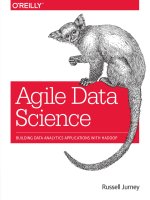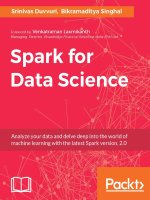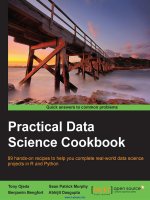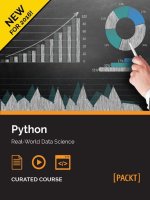Data science interview qnas
Bạn đang xem bản rút gọn của tài liệu. Xem và tải ngay bản đầy đủ của tài liệu tại đây (1.99 MB, 77 trang )
Arpit Singh
DATA SCIENCE:
Q1. What is Data Science? List the differences between supervised
and unsupervised learning.
Data Science is a blend of various tools, algorithms, and machine learning
principles with the goal to discover hidden patterns from the raw data.
How is this different from what statisticians have been doing for years?
The answer lies in the difference between explaining and predicting.
1
Follow Arpit Singh on LinkedIn for more such insightful posts
The differences between supervised and unsupervised learning are as
follows;
Supervised Learning
Input data is labelled.
Uses a training data set.
Used for prediction.
Enables classification and
regression.
Unsupervised Learning
Input data is unlabelled.
Uses the input data set.
Used for analysis.
Enables Classification, Density Estimation, &
Dimension Reduction
Q2. What is Selection Bias?
Selection bias is a kind of error that occurs when the researcher decides who is
going to be studied. It is usually associated with research where the selection
of participants isn‘t random. It is sometimes referred to as the selection effect.
It is the distortion of statistical analysis, resulting from the method of
collecting samples. If the selection bias is not taken into account, then some
conclusions of the study may not be accurate.
The types of selection bias include:
1. Sampling bias: It is a systematic error due to a non-random sample of
a population causing some members of the population to be less likely
to be included than others resulting in a biased sample.
2. Time interval: A trial may be terminated early at an extreme value
(often for ethical reasons), but the extreme value is likely to be reached
by the variable with the largest variance, even if all variables have a
similar mean.
3. Data: When specific subsets of data are chosen to support a conclusion
or rejection of bad data on arbitrary grounds, instead of according to
previously stated or generally agreed criteria.
4. Attrition: Attrition bias is a kind of selection bias caused by attrition
(loss of participants) discounting trial subjects/tests that did not run to
completion.
2
Follow Arpit Singh on LinkedIn for more such insightful posts
Q3. What is bias-variance trade-off?
Bias: Bias is an error introduced in your model due to oversimplification of
the machine learning algorithm. It can lead to underfitting. When you train
your model at that time model makes simplified assumptions to make the
target function easier to understand.
Low bias machine learning algorithms — Decision Trees, k-NN and SVM
High bias machine learning algorithms — Linear Regression, Logistic
Regression
Variance: Variance is error introduced in your model due to complex
machine learning algorithm, your model learns noise also from the training
data set and performs badly on test data set. It can lead to high sensitivity and
overfitting.
Normally, as you increase the complexity of your model, you will see a
reduction in error due to lower bias in the model. However, this only happens
until a particular point. As you continue to make your model more complex,
you end up over-fitting your model and hence your model will start suffering
from high variance.
3
Follow Arpit Singh on LinkedIn for more such insightful posts
Bias-Variance trade-off: The goal of any supervised machine learning
algorithm is to have low bias and low variance to achieve good prediction
performance.
1. The k-nearest neighbour algorithm has low bias and high variance, but
the trade-off can be changed by increasing the value of k which
increases the number of neighbours that contribute to the prediction
and in turn increases the bias of the model.
2. The support vector machine algorithm has low bias and high variance,
but the trade-off can be changed by increasing the C parameter that
influences the number of violations of the margin allowed in the
training data which increases the bias but decreases the variance.
There is no escaping the relationship between bias and variance in machine
learning. Increasing the bias will decrease the variance. Increasing the
variance will decrease bias.
Q4. What is a confusion matrix?
The confusion matrix is a 2X2 table that contains 4 outputs provided by
the binary classifier. Various measures, such as error-rate, accuracy,
specificity, sensitivity, precision and recall are derived from it.
Confusion Matrix
4
Follow Arpit Singh on LinkedIn for more such insightful posts
A data set used for performance evaluation is called a test data set. It should
contain the correct labels and predicted labels.
The predicted labels will exactly the same if the performance of a binary
classifier is perfect.
The predicted labels usually match with part of the observed labels in realworld scenarios.
A binary classifier predicts all data instances of a test data set as either
positive or negative. This produces four outcomes5
Follow Arpit Singh on LinkedIn for more such insightful posts
1.
2.
3.
4.
True-positive(TP) — Correct positive prediction
False-positive(FP) — Incorrect positive prediction
True-negative(TN) — Correct negative prediction
False-negative(FN) — Incorrect negative prediction
Basic measures derived from the confusion matrix
1.
2.
3.
4.
5.
6.
Error Rate = (FP+FN)/(P+N)
Accuracy = (TP+TN)/(P+N)
Sensitivity(Recall or True positive rate) = TP/P
Specificity(True negative rate) = TN/N
Precision(Positive predicted value) = TP/(TP+FP)
F-Score(Harmonic mean of precision and recall) =
(1+b)(PREC.REC)/(b²PREC+REC) where b is commonly 0.5, 1, 2.
6
Follow Arpit Singh on LinkedIn for more such insightful posts
STATISTICS:
Q5. What is the difference between “long” and “wide” format data?
In the wide-format, a subject‘s repeated responses will be in a single row,
and each response is in a separate column. In the long-format, each row is a
one-time point per subject. You can recognize data in wide format by the fact
that columns generally represent groups.
Q6. What do you understand by the term Normal Distribution?
Data is usually distributed in different ways with a bias to the left or to the
right or it can all be jumbled up.
However, there are chances that data is distributed around a central value
without any bias to the left or right and reaches normal distribution in the
form of a bell-shaped curve.
Figure: Normal distribution in a bell curve
7
Follow Arpit Singh on LinkedIn for more such insightful posts
The random variables are distributed in the form of a symmetrical, bellshaped curve.
Properties of Normal Distribution are as follows;
1.
2.
3.
4.
5.
Unimodal -one mode
Symmetrical -left and right halves are mirror images
Bell-shaped -maximum height (mode) at the mean
Mean, Mode, and Median are all located in the center
Asymptotic
Q7. What is correlation and covariance in statistics?
Covariance and Correlation are two mathematical concepts; these two
approaches are widely used in statistics. Both Correlation and Covariance
establish the relationship and also measure the dependency between two
random variables. Though the work is similar between these two in
mathematical terms, they are different from each other.
8
Follow Arpit Singh on LinkedIn for more such insightful posts
Correlation: Correlation is considered or described as the best technique for
measuring and also for estimating the quantitative relationship between two
variables. Correlation measures how strongly two variables are related.
Covariance: In covariance two items vary together and it‘s a measure that
indicates the extent to which two random variables change in cycle. It is a
statistical term; it explains the systematic relation between a pair of random
variables, wherein changes in one variable reciprocal by a corresponding
change in another variable.
Q8. What is the difference between Point Estimates and Confidence
Interval?
Point Estimation gives us a particular value as an estimate of a population
parameter. Method of Moments and Maximum Likelihood estimator methods
are used to derive Point Estimators for population parameters.
A confidence interval gives us a range of values which is likely to contain the
population parameter. The confidence interval is generally preferred, as it tells
us how likely this interval is to contain the population parameter. This
likeliness or probability is called Confidence Level or Confidence coefficient
and represented by 1 — alpha, where alpha is the level of significance.
Q9. What is the goal of A/B Testing?
It is a hypothesis testing for a randomized experiment with two variables A
and B.
The goal of A/B Testing is to identify any changes to the web page to maximize
or increase the outcome of interest. A/B testing is a fantastic method for
figuring out the best online promotional and marketing strategies for your
business. It can be used to test everything from website copy to sales emails to
search ads
An example of this could be identifying the click-through rate for a banner ad.
Q10. What is p-value?
9
Follow Arpit Singh on LinkedIn for more such insightful posts
When you perform a hypothesis test in statistics, a p-value can help you
determine the strength of your results. p-value is a number between 0 and 1.
Based on the value it will denote the strength of the results. The claim which is
on trial is called the Null Hypothesis.
Low p-value (≤ 0.05) indicates strength against the null hypothesis which
means we can reject the null Hypothesis. High p-value (≥ 0.05) indicates
strength for the null hypothesis which means we can accept the null
Hypothesis p-value of 0.05 indicates the Hypothesis could go either way. To
put it in another way,
High P values: your data are likely with a true null. Low P values: your data
are unlikely with a true null.
Q11. In any 15-minute interval, there is a 20% probability that you
will see at least one shooting star. What is the probability that you
see at least one shooting star in the period of an hour?
Probability of not seeing any shooting star in 15 minutes is
= 1 – P(Seeing one shooting star )
= 1 – 0.2
= 0.8
Probability of not seeing any shooting star in the period of one hour
= (0.8) ^ 4
= 0.4096
Probability of seeing at least one shooting star in the one hour
= 1 – P( Not seeing any star )
= 1 – 0.4096 = 0.5904
Q12. How can you generate a random number between 1 – 7 with
only a die?
Any die has six sides from 1-6. There is no way to get seven equal
outcomes from a single rolling of a die. If we roll the die twice and
consider the event of two rolls, we now have 36 different outcomes.
10
Follow Arpit Singh on LinkedIn for more such insightful posts
To get our 7 equal outcomes we have to reduce this 36 to a number
divisible by 7. We can thus consider only 35 outcomes and exclude the
other one.
A simple scenario can be to exclude the combination (6,6), i.e., to roll
the die again if 6 appears twice.
All the remaining combinations from (1,1) till (6,5) can be divided into 7
parts of 5 each. This way all the seven sets of outcomes are equally
likely.
Q13. A certain couple tells you that they have two children, at least
one of which is a girl. What is the probability that they have two
girls?
In the case of two children, there are 4 equally likely possibilities
BB, BG, GB and GG;
where B = Boy and G = Girl and the first letter denotes the first child.
From the question, we can exclude the first case of BB. Thus from the
remaining 3 possibilities of BG, GB & BB, we have to find the probability of
the case with two girls.
Thus, P(Having two girls given one girl) = 1 / 3
Q14. A jar has 1000 coins, of which 999 are fair and 1 is double
headed. Pick a coin at random, and toss it 10 times. Given that you
see 10 heads, what is the probability that the next toss of that coin
is also a head?
There are two ways of choosing the coin. One is to pick a fair coin and the
other is to pick the one with two heads.
Probability of selecting fair coin = 999/1000 = 0.999
Probability of selecting unfair coin = 1/1000 = 0.001
Selecting 10 heads in a row = Selecting fair coin * Getting 10
heads + Selecting an unfair coin
11
Follow Arpit Singh on LinkedIn for more such insightful posts
P (A) = 0.999 * (1/2)^5 = 0.999 * (1/1024) = 0.000976
P (B) = 0.001 * 1 = 0.001
P( A / A + B ) = 0.000976 / (0.000976 + 0.001) = 0.4939
P( B / A + B ) = 0.001 / 0.001976 = 0.5061
Probability of selecting another head = P(A/A+B) * 0.5 + P(B/A+B) * 1
= 0.4939 * 0.5 + 0.5061 = 0.7531
Q15. What do you understand by statistical power of sensitivity and
how do you calculate it?
Sensitivity is commonly used to validate the accuracy of a classifier (Logistic,
SVM, Random Forest etc.).
Sensitivity is nothing but ―Predicted True events/ Total events‖. True events
here are the events which were true and model also predicted them as true.
Calculation of seasonality is pretty straightforward.
Seasonality = ( True Positives ) / ( Positives in Actual Dependent
Variable )
Q16. Why Is Re-sampling Done?
Resampling is done in any of these cases:
Estimating the accuracy of sample statistics by using subsets of
accessible data or drawing randomly with replacement from a set of
data points
Substituting labels on data points when performing significance tests
Validating models by using random subsets (bootstrapping, crossvalidation)
Q17. What are the differences between over-fitting and underfitting?
12
Follow Arpit Singh on LinkedIn for more such insightful posts
In statistics and machine learning, one of the most common tasks is to fit
a model to a set of training data, so as to be able to make reliable predictions
on general untrained data.
In overfitting, a statistical model describes random error or noise instead of
the underlying relationship. Overfitting occurs when a model is excessively
complex, such as having too many parameters relative to the number of
observations. A model that has been overfitted, has poor predictive
performance, as it overreacts to minor fluctuations in the training data.
Underfitting occurs when a statistical model or machine learning algorithm
cannot capture the underlying trend of the data. Underfitting would occur, for
example, when fitting a linear model to non-linear data. Such a model too
would have poor predictive performance.
Q18. How to combat Overfitting and Underfitting?
To combat overfitting and underfitting, you can resample the data to estimate
the model accuracy (k-fold cross-validation) and by having a validation
dataset to evaluate the model.
Q19. What is regularisation? Why is it useful?
13
Follow Arpit Singh on LinkedIn for more such insightful posts
Regularisation is the process of adding tuning parameter to a model to induce
smoothness in order to prevent overfitting. This is most often done by adding
a constant multiple to an existing weight vector. This constant is often the
L1(Lasso) or L2(ridge). The model predictions should then minimize the loss
function calculated on the regularized training set.
Q20. What Is the Law of Large Numbers?
It is a theorem that describes the result of performing the same experiment a
large number of times. This theorem forms the basis of frequencystyle thinking. It says that the sample means, the sample variance and the
sample standard deviation converge to what they are trying to estimate.
Q21. What Are Confounding Variables?
In statistics, a confounder is a variable that influences both the dependent
variable and independent variable.
For example, if you are researching whether a lack of exercise leads to weight
gain,
lack of exercise = independent variable
weight gain = dependent variable.
A confounding variable here would be any other variable that affects both of
these variables, such as the age of the subject.
Q22. What Are the Types of Biases That Can Occur During
Sampling?
Selection bias
Under coverage bias
Survivorship bias
14
Follow Arpit Singh on LinkedIn for more such insightful posts
Q23. What is Survivorship Bias?
It is the logical error of focusing aspects that support surviving some process
and casually overlooking those that did not work because of their lack of
prominence. This can lead to wrong conclusions in numerous different means.
Q24. What is selection Bias?
Selection bias occurs when the sample obtained is not representative of the
population intended to be analysed.
Q25. Explain how a ROC curve works?
The ROC curve is a graphical representation of the contrast between true
positive rates and false-positive rates at various thresholds. It is often used as
a proxy for the trade-off between the sensitivity (true positive rate) and falsepositive rate.
15
Follow Arpit Singh on LinkedIn for more such insightful posts
Q26. What is TF/IDF vectorization?
TF–IDF is short for term frequency-inverse document frequency, is a
numerical statistic that is intended to reflect how important a word is to a
document in a collection or corpus. It is often used as a weighting factor in
information retrieval and text mining.
The TF–IDF value increases proportionally to the number of times a word
appears in the document but is offset by the frequency of the word in the
corpus, which helps to adjust for the fact that some words appear more
frequently in general.
Q27. Why we generally use Softmax non-linearity function as last
operation in-network?
It is because it takes in a vector of real numbers and returns a probability
distribution. Its definition is as follows. Let x be a vector of real numbers
(positive, negative, whatever, there are no constraints).
Then the i‘th component of Softmax(x) is —
It should be clear that the output is a probability distribution: each element is
non-negative and the sum over all components is 1.
16
Follow Arpit Singh on LinkedIn for more such insightful posts
DATA ANALYSIS:
Q28. Python or R – Which one would you prefer for text analytics?
We will prefer Python because of the following reasons:
Python would be the best option because it has Pandas library that
provides easy to use data structures and high-performance data analysis
tools.
R is more suitable for machine learning than just text analysis.
Python performs faster for all types of text analytics.
Q29. How does data cleaning plays a vital role in the analysis?
Data cleaning can help in analysis because:
Cleaning data from multiple sources helps to transform it into a format
that data analysts or data scientists can work with.
Data Cleaning helps to increase the accuracy of the model in machine
learning.
It is a cumbersome process because as the number of data sources
increases, the time taken to clean the data increases exponentially due
to the number of sources and the volume of data generated by these
sources.
It might take up to 80% of the time for just cleaning data making it a
critical part of the analysis task.
Q30. Differentiate between univariate, bivariate and multivariate
analysis.
Univariate analyses are descriptive statistical analysis techniques which can
be differentiated based on the number of variables involved at a given point of
time. For example, the pie charts of sales based on territory involve only one
variable and can the analysis can be referred to as univariate analysis.
17
Follow Arpit Singh on LinkedIn for more such insightful posts
The bivariate analysis attempts to understand the difference between two
variables at a time as in a scatterplot. For example, analyzing the volume of
sale and spending can be considered as an example of bivariate analysis.
Multivariate analysis deals with the study of more than two variables to
understand the effect of variables on the responses.
Q31. Explain Star Schema.
It is a traditional database schema with a central table. Satellite tables map
IDs to physical names or descriptions and can be connected to the central fact
table using the ID fields; these tables are known as lookup tables and are
principally useful in real-time applications, as they save a lot of memory.
Sometimes star schemas involve several layers of summarization to recover
information faster.
Q32. What is Cluster Sampling?
Cluster sampling is a technique used when it becomes difficult to study the
target population spread across a wide area and simple random sampling
cannot be applied. Cluster Sample is a probability sample where each
sampling unit is a collection or cluster of elements.
For eg., A researcher wants to survey the academic performance of high school
students in Japan. He can divide the entire population of Japan into different
clusters (cities). Then the researcher selects a number of clusters depending
on his research through simple or systematic random sampling.
Let‘s continue our Data Science Interview Questions blog with some more
statistics questions.
Q33. What is Systematic Sampling?
Systematic sampling is a statistical technique where elements are selected
from an ordered sampling frame. In systematic sampling, the list is
progressed in a circular manner so once you reach the end of the list, it is
18
Follow Arpit Singh on LinkedIn for more such insightful posts
progressed from the top again. The best example of systematic sampling is
equal probability method.
Q34. What are Eigenvectors and Eigenvalues?
Eigenvectors are used for understanding linear transformations. In data
analysis, we usually calculate the eigenvectors for a correlation or covariance
matrix. Eigenvectors are the directions along which a particular linear
transformation acts by flipping, compressing or stretching.
Eigenvalue can be referred to as the strength of the transformation in the
direction of eigenvector or the factor by which the compression occurs.
Q35. Can you cite some examples where a false positive is
important than a false negative?
Let us first understand what false positives and false negatives are.
False Positives are the cases where you wrongly classified a non-event
as an event a.k.a Type I error.
False Negatives are the cases where you wrongly classify events as
non-events, a.k.a Type II error.
Example 1: In the medical field, assume you have to give chemotherapy to
patients. Assume a patient comes to that hospital and he is tested positive for
cancer, based on the lab prediction but he actually doesn‘t have cancer. This is
a case of false positive. Here it is of utmost danger to start chemotherapy on
this patient when he actually does not have cancer. In the absence of
cancerous cell, chemotherapy will do certain damage to his normal healthy
cells and might lead to severe diseases, even cancer.
Example 2: Let‘s say an e-commerce company decided to give $1000 Gift
voucher to the customers whom they assume to purchase at least $10,000
worth of items. They send free voucher mail directly to 100 customers without
any minimum purchase condition because they assume to make at least 20%
profit on sold items above $10,000. Now the issue is if we send the $1000 gift
vouchers to customers who have not actually purchased anything but are
marked as having made $10,000 worth of purchase.
19
Follow Arpit Singh on LinkedIn for more such insightful posts
Q36. Can you cite some examples where a false negative important
than a false positive?
Example 1: Assume there is an airport ‗A‘ which has received high-security
threats and based on certain characteristics they identify whether a particular
passenger can be a threat or not. Due to a shortage of staff, they decide to scan
passengers being predicted as risk positives by their predictive model. What
will happen if a true threat customer is being flagged as non-threat by airport
model?
Example 2: What if Jury or judge decides to make a criminal go free?
Example 3: What if you rejected to marry a very good person based on your
predictive model and you happen to meet him/her after a few years and
realize that you had a false negative?
Q37. Can you cite some examples where both false positive and
false negatives are equally important?
In the Banking industry giving loans is the primary source of making money
but at the same time if your repayment rate is not good you will not make any
profit, rather you will risk huge losses.
Banks don‘t want to lose good customers and at the same point in time, they
don‘t want to acquire bad customers. In this scenario, both the false positives
and false negatives become very important to measure.
Q38. Can you explain the difference between a Validation Set and a
Test Set?
A Validation set can be considered as a part of the training set as it is used
for parameter selection and to avoid overfitting of the model being built.
On the other hand, a Test Set is used for testing or evaluating the
performance of a trained machine learning model.
20
Follow Arpit Singh on LinkedIn for more such insightful posts
In simple terms, the differences can be summarized as; training set is to fit the
parameters i.e. weights and test set is to assess the performance of the model
i.e. evaluating the predictive power and generalization.
Q39. Explain cross-validation.
Cross-validation is a model validation technique for evaluating how the
outcomes of statistical analysis will generalize to an independent
dataset. Mainly used in backgrounds where the objective is forecast and one
wants to estimate how accurately a model will accomplish in practice.
The goal of cross-validation is to term a data set to test the model in the
training phase (i.e. validation data set) in order to limit problems like
overfitting and get an insight on how the model will generalize to an
independent data set.
21
Follow Arpit Singh on LinkedIn for more such insightful posts
MACHINE LEARNING:
Q40. What is Machine Learning?
Machine Learning explores the study and construction of algorithms that
can learn from and make predictions on data. Closely related to computational
statistics. Used to devise complex models and algorithms that lend themselves
to a prediction which in commercial use is known as predictive analytics.
Given below, is an image representing the various domains Machine Learning
lends itself to.
Q41. What is Supervised Learning?
Supervised learning is the machine learning task of inferring a function
from labeled training data. The training data consist of a set of training
examples.
Algorithms: Support Vector Machines, Regression, Naive Bayes, Decision
Trees, K-nearest Neighbor Algorithm and Neural Networks
E.g. If you built a fruit classifier, the labels will be “this is an orange, this is
an apple and this is a banana”, based on showing the classifier examples of
apples, oranges and bananas.
Q42. What is Unsupervised learning?
Unsupervised learning is a type of machine learning algorithm used to
draw inferences from datasets consisting of input data without labelled
responses.
Algorithms: Clustering, Anomaly Detection, Neural Networks and Latent
Variable Models
22
Follow Arpit Singh on LinkedIn for more such insightful posts
E.g. In the same example, a fruit clustering will categorize as “fruits with soft
skin and lots of dimples”, “fruits with shiny hard skin” and “elongated yellow
fruits”.
Q43. What are the various classification algorithms?
The diagram lists the most important classification algorithms.
Q44. What is „Naive‟ in a Naive Bayes?
The Naive Bayes Algorithm is based on the Bayes Theorem. Bayes‘
theorem describes the probability of an event, based on prior knowledge of
conditions that might be related to the event.
The Algorithm is ‗naive‘ because it makes assumptions that may or may not
turn out to be correct.
Q45. Explain SVM algorithm in detail.
SVM stands for support vector machine, it is a supervised machine learning
algorithm which can be used for both Regression and Classification. If
you have n features in your training data set, SVM tries to plot it in ndimensional space with the value of each feature being the value of a
particular coordinate. SVM uses hyperplanes to separate out different classes
based on the provided kernel function.
23
Follow Arpit Singh on LinkedIn for more such insightful posts
Q46. What are the support vectors in SVM?
In the diagram, we see that the thinner lines mark the distance from the
classifier to the closest data points called the support vectors (darkened data
points). The distance between the two thin lines is called the margin.
24
Follow Arpit Singh on LinkedIn for more such insightful posts
Q47. What are the different kernels in SVM?
There are four types of kernels in SVM.
1.
2.
3.
4.
Linear Kernel
Polynomial kernel
Radial basis kernel
Sigmoid kernel
Q48. Explain Decision Tree algorithm in detail.
A decision tree is a supervised machine learning algorithm mainly used
for Regression and Classification. It breaks down a data set into smaller
and smaller subsets while at the same time an associated decision tree is
incrementally developed. The final result is a tree with decision nodes and leaf
nodes. A decision tree can handle both categorical and numerical data.
Q49. What are Entropy and Information gain in Decision tree
algorithm?
The core algorithm for building a decision tree is
called ID3. ID3 uses Entropy and Information Gain to construct a
decision tree.
Entropy
25









